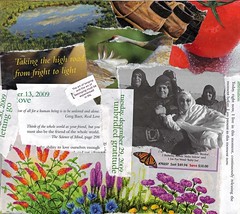The posting below is an excerpt from a paper written by the blogger for a graduate level MLIS class. Searches using metatags work similar to how a web search is done on the Internet. Tools called "crawlers" scourer the indexes for hundreds of records and complie a list of the relevant results. What they find is called a metatag, a keyword that is not visible in the document itself, but that can be picked up by these search engines within the record’s index. Schatz (2005) states in his article that "anyone who has tried to find useful information via search engines knows the frustration of information overload" (p70). He recommends that designers include metatags in their records to make searching easier for users. Sometimes, however, there just aren’t the resources to include all of this information in the record for one reason or another. Sometimes it comes down to a judgment call by the cataloger because there must be uniformity in how the descriptors are worded in a record.
Unified Descriptors A downside to use of metatags is that there can be hundreds of descriptors for the same term. The more tags, the less uniform the record becomes. The Dublin Core schema is the only tag set that has been adopted as a standard. They are simplified tags, less than 20 in actuality. It is meant to be a universal tag set with a broader application appeal. However, in one word, they are generic.
Some groups have created tags specifically for their own organizations uses, but again not all tags fit all situations. Library catalog systems that allow their patrons to tag records may end up with a very detailed if not extensive collection of tags for those records. This would result in more specific search results, but in a way this is also information overload for the organization. If the organization does allow for open tagging, then there must be someone tasked with the role of sifting through the metatags to weed out the redundant or unrelated. This might, however, result in more difficulty for metasearching across the different databases and institutions but more usability from within. (Woodley, 2008)
CONCLUSION Allowing users to create their own metadata on a local level can allow for a more user specific searching experience. Rather than trying to guess which words a user is most likely to use, the system can learn from the searches and results that have been generated by previous users. Integrating a system that allows for a unified metadata schema would allow for more institutional usability, but allowing for user defined metadata would best serve library users.
Schatz, S. (2005). Unique metadata schemas: A model for user-centric design of a performance support system. Educational Technology Research & Development , 53 (4), 69-84.
Woodley, M. (2008). Crosswalks, Metadata Harvesting, Federated Searching, Metasearching. In T. Gill, A. Gilliland, M. Whalen, & M. & Woodley, Introduction to Metadata, Online Edition, Version 3.0. Los Angeles, CA: Getty Publications.Educational Technology Research & Development , 53 (4), 69-84.
>>>>>Tagging is a great way to search for things. In Delicious, you can click on your TAGs to see a list of everything that you assigned that TAG. You can also click on other users who also bookmarked the site and check out the TAGs they have listed for things.
Check out my Delicious links on the right ;)

